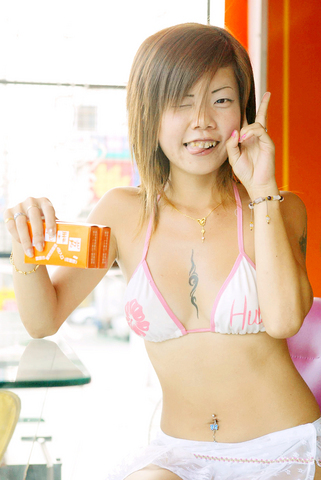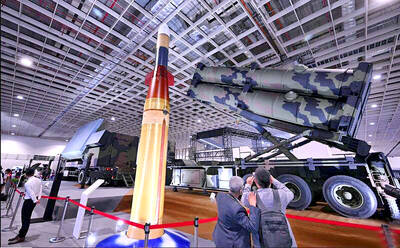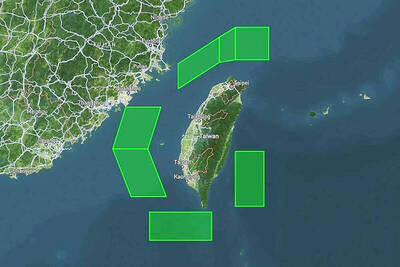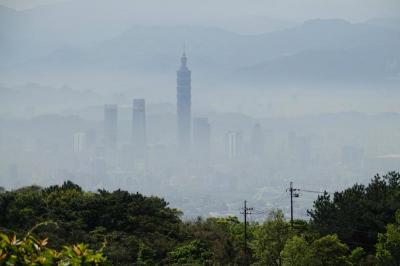Taiwan's unique betel-nut beauties have long been the subject of debates on the issues of the objectification of women's bodies and females' freedom to develop their own self-image.
Years after those scantily-clad girls became a distinctive phenomenon in the country -- even drawing attention from international media including CNN and the BBC -- an installation art show has put aside the disputes and attempted to display the social and cultural effects of betel-nut beauties through art.
"Betel-nut beauties are a reflection of the local culture in Taiwan, and also a common experience shared by all Taiwanese. My work is about documenting these women, without any judgment of morality," said artist Wu Chung-hua (吳瓊華), general director of Taiwan Women's Art Association, who has spent 10 years studying the lives of betel-nut beauties.

PHOTO: HSIEH FUNG-CHIU, TAIPEI TIMES
With dummies dressed up with bras and boots, and colorful paintings of sexy girls with huge breasts, the "Made in Taiwan Betel-nut Beauties" installation art exhibition, which opened last Sunday at the Taipei 101 Mall, demonstrates the image of betel-nut beauties of different generations, from working-class middle-aged women to the sexy girls who wear almost nothing in order to attract more business.
After a two-year field study of betel-nut stands in which she conducted interviews with more than 100 betel-nut beauties, Wu said that despite criticism from conservatives and strict regulations by local governments, the industry continues to thrive. And the image of betel-nut beauties has undergone a transformation.
"Male control over female bodies as a commodity definitely exists in the industry. But with more girls choosing to dress sexily in exchange for more earnings, I think the industry has transformed into one with more female awareness of the power of their bodies," she said.
While Wu stressed that the show focused on the artistry of the betel-nut beauties' images, the issues hidden behind the art remain open to debate.
Defending the autonomy of betel-nut beauties, Josephine Ho (何春蕤) shrugged off criticism that these women damage the nation's moral climate.
"The betel-nut beauties have every right to dress freely, and deserve to have the chance to actively strive for economic gain. They affirm the attractiveness of their own bodies and make an honest living, and what's wrong with that?" said Ho, coordinator of the Center for the Study of Sexuality at National Central University.
According to Ho, who has studied the betel-nut beauty phenomena for years, betel-nut girls are mostly from working class backgrounds and their outfits are merely a way of earning more money. Society should stop judging them from a patriarchal point of view.
Some women's rights advocates, however, have a less sympathetic view of the beauties.
"Those women are being exploited. They aren't revealing their bodies out of a sense of autonomy or freedom. Instead, they are catering to patriarchal notions of beauty. They strive to please men and finally become products to be consumed," said Chi Hui-jung (紀惠容), chief executive officer at the Garden of Hope Foundation.
According to industry estimates, there are roughly 100,000 kiosks selling betel nuts across the nation.
To attract more customers, vendors started hiring scantily clad young women in 1996. When a few cases of prostitution associated with betel-nut vending became known, critics said the women were damaging the nation's moral climate and that the government should take measures to crack down on the trade.
The "Made in Taiwan Betel-nut Beauties" exhibition runs through May 29 at Page One Bookstore of the Taipei 101 Mall. Call the bookstore at 02-8101-8282 ext. 6677 or 6699 for more information.

Taiwan is to commence mass production of the Tien Kung (天弓, “Sky Bow”) III, IV and V missiles by the second quarter of this year if the legislature approves the government’s NT$1.25 trillion (US$39.78 billion) special defense budget, an official said yesterday. Commenting on condition of anonymity, a defense official with knowledge of the matter said that the advanced systems are expected to provide crucial capabilities against ballistic and cruise missiles for the proposed “T-Dome,” an advanced, multi-layered air defense network. The Tien Kung III is an air defense missile with a maximum interception altitude of 35km. The Tien Kung IV and V

The disruption of 941 flights in and out of Taiwan due to China’s large-scale military exercises was no accident, but rather the result of a “quasi-blockade” used to simulate creating the air and sea routes needed for an amphibious landing, a military expert said. The disruptions occurred on Tuesday and lasted about 10 hours as China conducted live-fire drills in the Taiwan Strait. The Civil Aviation Administration (CAA) said the exercises affected 857 international flights and 84 domestic flights, affecting more than 100,000 travelers. Su Tzu-yun (蘇紫雲), a research fellow at the government-sponsored Institute for National Defense and Security Research, said the air

Taiwan lacks effective and cost-efficient armaments to intercept rockets, making the planned “T-Dome” interception system necessary, two experts said on Tuesday. The concerns were raised after China’s military fired two waves of rockets during live-fire drills around Taiwan on Tuesday, part of two-day exercises code-named “Justice Mission 2025.” The first wave involved 17 rockets launched at 9am from Pingtan in China’s Fujian Province, according to Lieutenant General Hsieh Jih-sheng (謝日升) of the Office of the Deputy Chief of the General Staff for Intelligence at the Ministry of National Defense. Those rockets landed 70 nautical miles (129.6km) northeast of Keelung without flying over Taiwan,

A strong continental cold air mass is to bring pollutants to Taiwan from tomorrow, the Ministry of Environment said today, as it issued an “orange” air quality alert for most of the country. All of Taiwan except for Hualien and Taitung counties is to be under an “orange” air quality alert tomorrow, indicating air quality that is unhealthy for sensitive groups. In China, areas from Shandong to Shanghai have been enveloped in haze since Saturday, the ministry said in a news release. Yesterday, hourly concentrations of PM2.5 in these areas ranged from 65 to 160 micrograms per cubic meter (mg/m³), and pollutants were